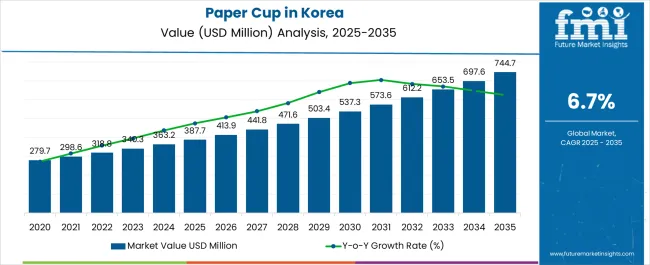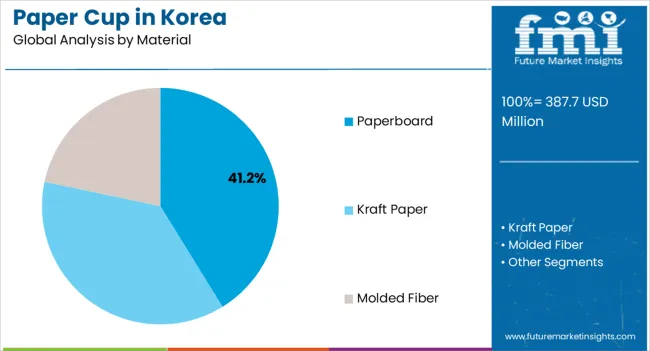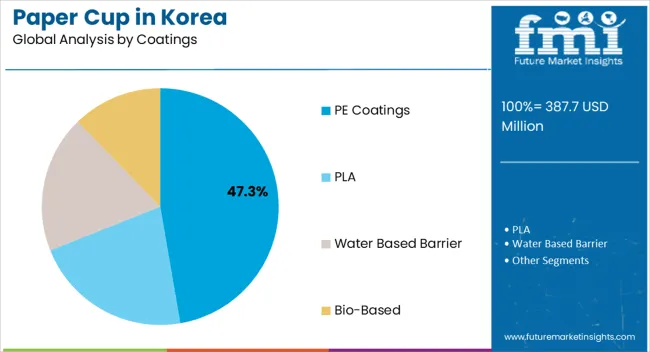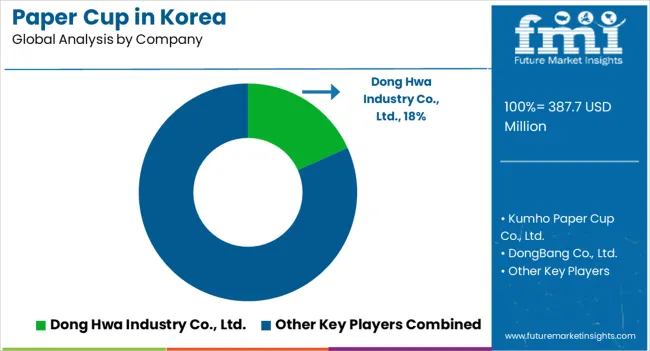The Demand and Sales Analysis of Paper Cup in Korea is estimated to be valued at USD 387.7 million in 2025 and is projected to reach USD 744.7 million by 2035, registering a compound annual growth rate (CAGR) of 6.7% over the forecast period.

| Metric | Value |
|---|---|
| Demand and Sales Analysis of Paper Cup in Korea Estimated Value in (2025 E) | USD 387.7 million |
| Demand and Sales Analysis of Paper Cup in Korea Forecast Value in (2035 F) | USD 744.7 million |
| Forecast CAGR (2025 to 2035) | 6.7% |
The paper cup market in Korea is experiencing robust growth. Increasing consumer preference for disposable beverage containers, rising café culture, and expanding foodservice and takeaway sectors are driving demand. Current market dynamics are influenced by innovations in cup design, sustainability initiatives, and regulatory measures addressing environmental impact.
The future outlook is shaped by growing adoption of eco-friendly materials, development of biodegradable and recyclable options, and strategic investments by manufacturers to enhance production efficiency and distribution networks. Growth rationale is supported by consistent demand from urban consumers and commercial establishments, technological advancements in manufacturing and coating processes that improve product quality, and the ability of market players to meet evolving consumer expectations.
Expansion is also being reinforced by rising awareness of hygiene and convenience in disposable products Collectively, these factors underpin steady revenue growth and sustained market penetration over the forecast period.
The 8 Oz segment, representing 36.50% of the capacity / wall type category, has emerged as the leading choice due to its suitability for standard beverage serving sizes and widespread adoption in cafés and fast-food outlets. Market preference has been reinforced by balanced material usage and manufacturing efficiency, which allow producers to maintain cost-effective production while meeting consumer demand.
Functional design, combined with durability and thermal insulation properties, has strengthened acceptance among end-users. Supply chain reliability and consistent quality have contributed to sustaining market confidence.
Growth potential is further enhanced by product standardization that aligns with operational requirements of foodservice providers and packaging regulations Innovations in wall thickness and cup structure are expected to maintain the segment’s market share and support incremental adoption across both retail and commercial channels.

The paperboard segment, accounting for 41.20% of the material category, has maintained its leading position due to its structural integrity, versatility, and compatibility with diverse printing and branding requirements. Adoption has been facilitated by high availability, cost-effectiveness, and the ability to meet both hygiene and sustainability standards.
Paperboard’s robustness supports multiple beverage types and temperatures, which reinforces its preference in both retail and commercial applications. Manufacturing efficiency, coupled with consistent quality and regulatory compliance, has further strengthened market confidence.
Ongoing innovation in sourcing and processing techniques, including the use of recycled fibers and sustainable forestry practices, is expected to sustain the segment’s market share and enhance environmental positioning, ensuring continued relevance in the Korean paper cup market.

The PE coatings segment, holding 47.30% of the coatings category, has emerged as the leading choice due to its water-resistant properties, durability, and compatibility with standard paperboard substrates. Market adoption has been driven by the need to prevent leakage, improve beverage retention, and maintain cup structural integrity.
Functional benefits, combined with ease of manufacturing and cost efficiency, have reinforced preference among producers and end-users. Regulatory adherence and consistent coating application quality have contributed to sustained market confidence.
Growth is further supported by ongoing R&D in coating technologies that optimize environmental performance and enhance recyclability Continued focus on improving coating efficiency and integrating sustainable alternatives is expected to maintain the segment’s market share and strengthen its position in the evolving Korean paper cup landscape.
The table indicates that the paperboard segment dominates the industry by material type, acquiring a share of 55.1% in 2025. The table further details end use category and show that the beverage segment leads with a value share of 68.5% in 2025.
| Category | Industry Share in 2025 |
|---|---|
| Paperboard | 55.1% |
| Beverages | 68.5% |
South Korea has been actively promoting eco-friendly practices, and there is a growing trend towards sustainable materials. Paperboard cups align well with this ethos, as they are biodegradable and recyclable. Moreover, cultural preferences also come into play. Traditional Korean dining customs often involve hot beverages like tea or coffee, and paperboard cups provide a convenient and practical solution for takeout or on-the-go consumption. As Korea's hospitality industry gears itself for a new deposit program in December 2025, the number of paperboard cups supplied across 14 café chains and four fast-food restaurants has surged 30% since the pandemic began.
The local paper industry in Korea has seen considerable advancements in technology and infrastructure. This has led to the production of high-quality paperboard material that meets the stringent standards set by both regulatory bodies and consumers. This quality assurance has bolstered the confidence of businesses and consumers in choosing paperboard cups.
The culture of coffee is well entrenched in Korea. The country has one of the maximum per-capita coffee consumption rates in the world. Consumers in this country favor takeout coffee due to their passion for on-the-go lifestyles, which has increased demand for paper cups. The growth of coffee shop chains, both local and foreign, throughout urban areas only serves to further support this tendency.
Korea's culture of convenience stores is prominent. These shops, which are common in cities, sell a variety of drinks. Customers want grab-and-go alternatives because of how quickly modern life moves; thus, paper cups are the container of choice.
South Gyeongsang province in South Korea is a significant hub for various industries, including the paper cup industry. The province is home to numerous manufacturers, ranging from small enterprises to large-scale companies, producing a wide range of paper cup products. These businesses contribute significantly to the local economy and also play a role in the larger context of South Korea's export-oriented manufacturing sector.
The industry in South Gyeongsang province is likely to be influenced by global trends such as the shift toward eco-friendly and sustainable packaging. Local companies might face challenges related to compliance with international quality standards and evolving environmental regulations.
South Gyeongsang, North Jeolla, South Jeolla, and Jeju are other regions playing key roles in the Korea paper cup industry.

The paper cup industry in Korea has become more dispersed. Customers are open to new ideas, making it simple for new businesses to enter Korea for paper cup. Gaining consumer loyalty is tough at first appearance. To retain customers, reputable brands continue to deliver the taste of fresh features powered by technology.
When emerging firms form alliances with leading corporations, they are likely to acquire significant exposure. Deploying technology correctly can aid in route optimization, assuring efficient delivery.
The emergence of super applications is another important competitive touchpoint. Key players in Korea keep expanding their operations beyond a particular category to provide their users with an all-inclusive approach.
| Attributes | Details |
|---|---|
| Industry Size of Korea in 2025 | USD 387.7 million |
| Expected Industry Size in 2035 | USD 744.7 million |
| CAGR from 2025 to 2035 | 6.7% |
| Historical Analysis of Demand for Paper Cup in Korea | 2020 to 2025 |
| Demand Forecast for Paper Cup in Korea | 2025 to 2035 |
| Report Coverage | Industry Size, Industry Trends, Analysis of key factors influencing Paper Cup Adoption in Korea, Insights on Industry Players and their Industry Strategy in Korea, Ecosystem Analysis of Local and Regional Korea Providers |
| Key Regions Analyzed While Studying Opportunities in Paper Cup in Korea | South Gyeongsang, North Jeolla, South Jeolla, Jeju |
| Key Companies Profiled | Dong Hwa Industry Co., Ltd.; Kumho Paper Cup Co., Ltd.; DongBang Co., Ltd.; Daesung Paper Cup Co., Ltd.; Woosung Paper Co., Ltd.; Hwaseung Industries Co., Ltd.; Hwasung Paper Co., Ltd. |
The global demand and sales analysis of paper cup in Korea is estimated to be valued at USD 387.7 million in 2025.
The market size for the demand and sales analysis of paper cup in Korea is projected to reach USD 744.7 million by 2035.
The demand and sales analysis of paper cup in Korea is expected to grow at a 6.7% CAGR between 2025 and 2035.
The key product types in demand and sales analysis of paper cup in Korea are 8 oz, _single wall, _double wall, _ripple wall, 4 oz, _single wall, _double wall, _ripple wall, 12 oz, _single wall, _double wall, _ripple wall, 16 oz, _single wall, _double wall, _ripple wall, 20 oz, _single wall, _double wall, _ripple wall, other capacities, _single wall, _double wall and _ripple wall.
In terms of material, paperboard segment to command 41.2% share in the demand and sales analysis of paper cup in Korea in 2025.






Full Research Suite comprises of:
Market outlook & trends analysis
Interviews & case studies
Strategic recommendations
Vendor profiles & capabilities analysis
5-year forecasts
8 regions and 60+ country-level data splits
Market segment data splits
12 months of continuous data updates
DELIVERED AS:
PDF EXCEL ONLINE
Demand Signal Repository Solutions Market Size and Share Forecast Outlook 2025 to 2035
Demand Side Management Market Size and Share Forecast Outlook 2025 to 2035
Demand Response Market Analysis - Size, Share, and Forecast Outlook 2025 to 2035
Demand for Industrial Chocolate in EU Size and Share Forecast Outlook 2025 to 2035
Demand for Industrial & Institutional Cleaning Products in EU Size and Share Forecast Outlook 2025 to 2035
Demand for Joint Compound in EU Size and Share Forecast Outlook 2025 to 2035
Demand for Taurine in EU Size and Share Forecast Outlook 2025 to 2035
Demand for Kaolin in India Size and Share Forecast Outlook 2025 to 2035
Demand for DMPA in EU Size and Share Forecast Outlook 2025 to 2035
Demand for 3D Printing Materials in Middle East Size and Share Forecast Outlook 2025 to 2035
Demand for Protein-rich Shelf-stable UHT Oat Drinks in Latin America Size and Share Forecast Outlook 2025 to 2035
Demand for Yeast in EU Size and Share Forecast Outlook 2025 to 2035
Demand for Oat Drink in EU Size and Share Forecast Outlook 2025 to 2035
Demand for Vanillin in EU Size and Share Forecast Outlook 2025 to 2035
Demand for Spirulina Extract in EU Size and Share Forecast Outlook 2025 to 2035
Demand for Pulse Ingredients in EU Size and Share Forecast Outlook 2025 to 2035
Demand for Gypsum in EU Size and Share Forecast Outlook 2025 to 2035
Demand for Barite in EU Size and Share Forecast Outlook 2025 to 2035
Demand for Shrimp in the EU Size and Share Forecast Outlook 2025 to 2035
Demand for Mezcal in EU Size and Share Forecast Outlook 2025 to 2035

Thank you!
You will receive an email from our Business Development Manager. Please be sure to check your SPAM/JUNK folder too.
Chat With
MaRIA